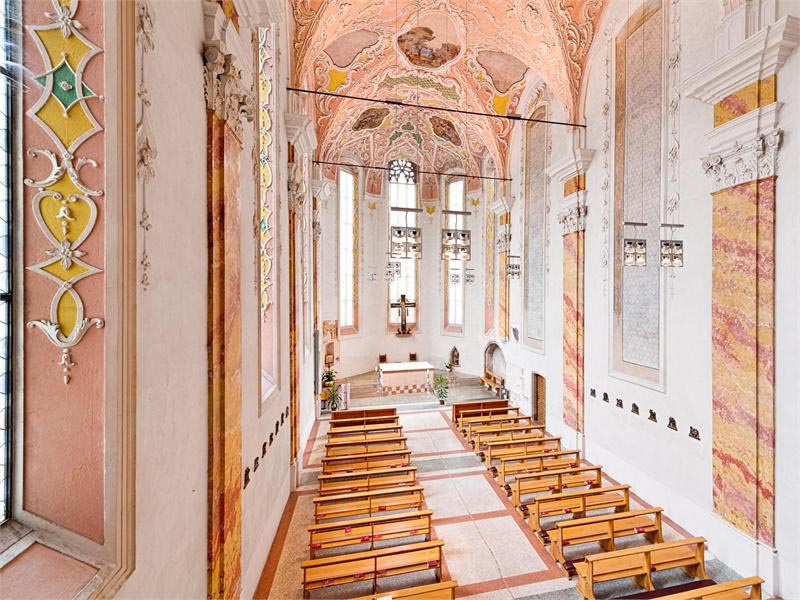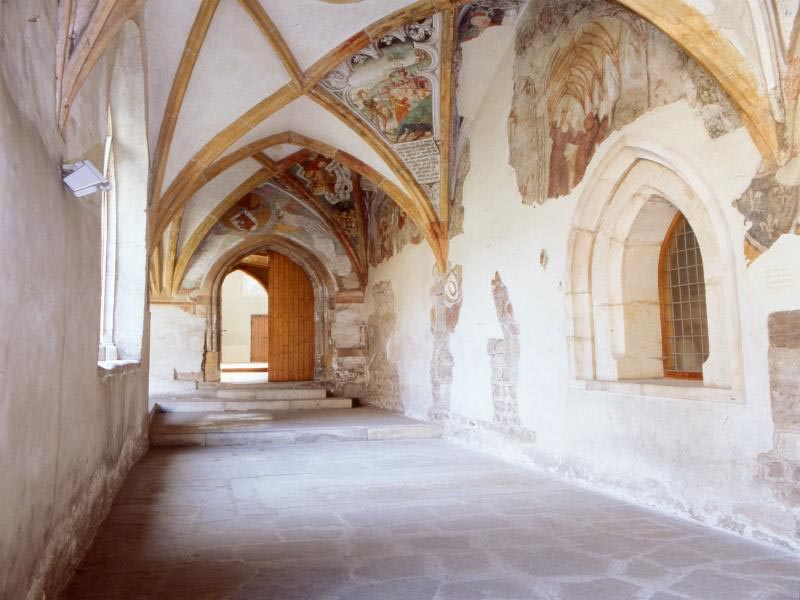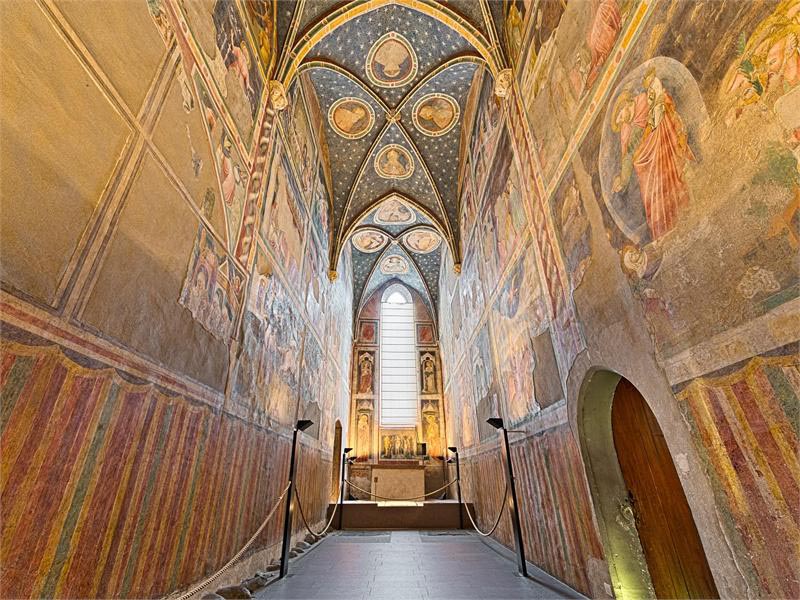Complesso dei Domenicani
 Chiese
Chiese
-
 0471982027
0471982027
-
 info@dompfarre.bz.it
info@dompfarre.bz.it
-
 sito web
sito web
-
Lun 08.00 - 18.00 Mar 08.00 - 18.00 Mer 08.00 - 18.00 Gio 08.00 - 18.00 Ven 08.00 - 18.00 Sab 08.00 - 18.00 Dom 12.00 - 18.00
Descrizione
I frati Domenicani si stabiliscono a Bolzano nel 1272 e fanno edificare una chiesa a navata unica all'interno di un vasto complesso conventuale che comprende diverse cappelle, alcune distrutte, e uno splendido chiostro. una parte dell'antica struttura é oggi il Conservatorio di Musica, sede, fra l'altro, del prestigioso Consorso Pianistico Internazionale Ferruccio Busoni, della Galleria Civica, sede di mostre e di altre importanti istituzioni culturali. La chiesa subisce la dotazione di Volte gotiche, di elementi barocchi nel Seicento e Settecento (a sinistra dell'altare Maggiore si trova una pala del Guercino, finanziata dai commercianti bolzanini). La chiesa conserva prestigiosi esempi di pittura bolzanina del Trencento sul lato Orientale del chiostro e sulla parete occidentale delal chiesa, ma il gioiello artistico del complesso è la cappella di San Giovanni, la lunga e Stretta cappella laterale che conserva il ciclo di affreschi di scuola giottesca più prestigioso del circondario. E' dedicata a San Giovanni, dal nome del capofamiglia fiorentino de' Rossi, naturlaizzato von Botsch, che ne commissiona la decorazione. Particolarmente significative sono le Scene della vita di San Nicolò sull'ultimo registro della parete Orientale, l'affresco del Trionfo della Morte nel primo registro della stessa, la Fuga in Egitto sulla parete occidentale e la Tortura di San Bartolomeo sull aparete nord. Tutta la cappella, affrescata senza soluzione di continuità, è uno splendido esempio di arte del Trecento. Nel chiostro attiguo (ingresso da Piazza Domenicani) si possono ammirare alcuni affreschi di Friedrich Pacher, databili al 1496.
The Dominican order established itself in Bolzano/Bozen in 1272 and built a church with a single nave inside a vast convent which branches off into different chapels, some of which have been lying in ruins, and a beautiful cloister. A part of the ancient structure houses the Music Academy shich, indidentally, Hosts the prestigious international piano competition Ferruccio Busoni. Also present is the Stadtgalerie, an art gallery which holds different exhibitions and other important cultural Events. The church has gothic archways, as well as baroque elements from the 17th and 18th century (such as the altar piece of Guercino to the left of the Major altar, which was bought by the merchants of Bolzano). The church preserves prestigious examples of paintings from Bolzano from the 14th century which can be found on the oriental side of the coister and on the western wall of the Church, but the real artistic jewel of the building is the Chapel of St. John, the Long and narrow side chapel which holds the cycle of frescoes of those painters who took Giotto es their role model, the so called "School of Giotto". Of particular interest are those scenes from the life of St. Nicholas on the last part of the oriental qall, and the fresco of the "Triumph over death " in the firs part of the same wall, the flight from Egypt on the western wall and the torture of St. Bartholomew on the northern wall. The entire chapel, decorated with individual frescoes of various themes, is a splendid example of 14th century art as practised in the Region. In the nearby coister you can also admire some frescoes by Friedrich Pacher which go back as far as 496.
Die Mönche des Dominikanerordens ließen sich 1272 in Bozen nieder und errichteten eine einschiffige Kirche in einer weitläufigen Klosteranlage mit Kreuzgang, in der auch verschiedene Kapellen Platz fanden, einige davon sind mittlerweile zerstört. einen Teil der alten Anlage bilden die Stadtgalerie mit ihren Ausstellungen und das heutige Musikkonservatorium, Sitz des renommierten internationalen Klavierwettbewerbs Ferruccio Busoni. Die Dominikanerkirche ist eine gotische Klosterkirche mit barocken Elementen aus dem 17. und 18. Jahrhundert (links vom Hauptaltar befindet sich ein Altarbild des Guercino, gestiftet von einer Bozner Kaufmannsfamilie). Die Kirche beherbergt einige der wichtigsten Kunstwerke Bozens, Gemälde der Bozner Schule des 14. Jh. auf der östlichen Kreuzgangseite und auf der Westwand der Kirche. Doch das eigentliche Schmuckstück ist die Johanneskapelle, eine hohe und schmale Seitenkapelle mit einem der bedeutendsten Freskenzyklen der Gegend, aus der Kunstschule des Giotto. Die Kapelle wurde von der Stifterfamilie de' Rossi (ursprünglich aus Florenz, eingebürgert als von Botsch) dem heiligen Johannes gewidmet, nachdem das Familienoberhaupt Johannes hieß. Erwähnenswert sind die Szenen aus dem leben des hl. Nikolaus und "der Triumph des Todes" an der Ostwand, die Flucht aus Ägypten an der Westwand und das Martyrium des hl. Bartholomäus an der Nordwand. Die Kapelle voller Fresken ist ein wunderbares Zeugnis der Bozner Wandmalerei des 14. Jh. Sehenswert im angrenzenden Kreuzgang (Eingang am Dominikanerplatz) sind Fresken von Friedrich Pacher aus dem Jahr 1496.
The Dominican order established itself in Bolzano/Bozen in 1272 and built a church with a single nave inside a vast convent which branches off into different chapels, some of which have been lying in ruins, and a beautiful cloister. A part of the ancient structure houses the Music Academy shich, indidentally, Hosts the prestigious international piano competition Ferruccio Busoni. Also present is the Stadtgalerie, an art gallery which holds different exhibitions and other important cultural Events. The church has gothic archways, as well as baroque elements from the 17th and 18th century (such as the altar piece of Guercino to the left of the Major altar, which was bought by the merchants of Bolzano). The church preserves prestigious examples of paintings from Bolzano from the 14th century which can be found on the oriental side of the coister and on the western wall of the Church, but the real artistic jewel of the building is the Chapel of St. John, the Long and narrow side chapel which holds the cycle of frescoes of those painters who took Giotto es their role model, the so called "School of Giotto". Of particular interest are those scenes from the life of St. Nicholas on the last part of the oriental qall, and the fresco of the "Triumph over death " in the firs part of the same wall, the flight from Egypt on the western wall and the torture of St. Bartholomew on the northern wall. The entire chapel, decorated with individual frescoes of various themes, is a splendid example of 14th century art as practised in the Region. In the nearby coister you can also admire some frescoes by Friedrich Pacher which go back as far as 496.



